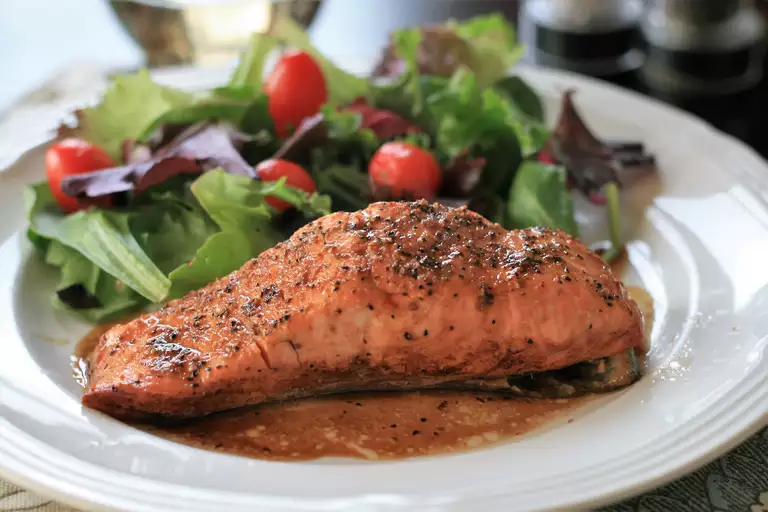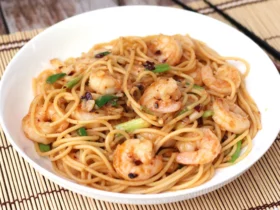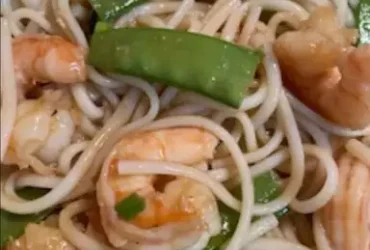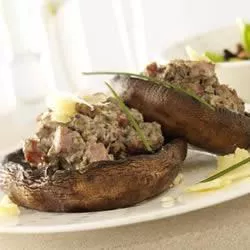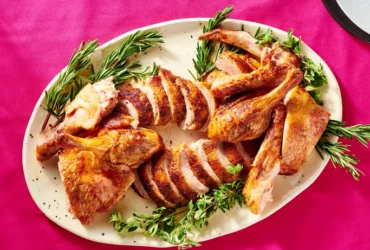Background and History
Baked salmon is a popular dish worldwide due to its simplicity, health benefits, and delicious flavor. Salmon has been a staple in many cultures, particularly among coastal and northern populations where it is abundant. Baking salmon became popular for its ease and the ability to infuse flavors without the hassle of more complicated cooking methods. This recipe focuses on minimizing cleanup while delivering a healthy, flavorful meal.
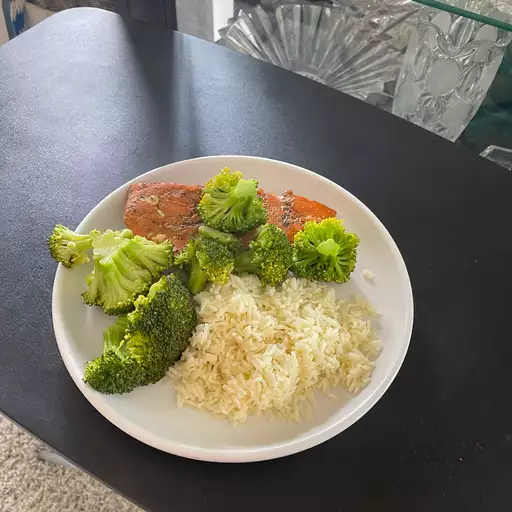
Serves
- 4 servings
Time
- Preparation Time: 10 minutes
- Cooking Time: 20 minutes
Ingredients
- 4 salmon fillets (about 6 ounces each)
- 2 tablespoons olive oil
- 1 lemon, thinly sliced
- 2 tablespoons fresh dill, chopped (or 1 tablespoon dried dill)
- 2 cloves garlic, minced
- Salt and pepper to taste
- Optional: a handful of cherry tomatoes or asparagus spears for added flavor and nutrition
Instructions
Preheat Oven: Preheat your oven to 375°F (190°C).
Prepare Baking Sheet
- Line a baking sheet with parchment paper or aluminum foil for easy cleanup.
Prepare Salmon
- Place the salmon fillets on the prepared baking sheet.
- Drizzle olive oil over each fillet and rub it in to coat evenly.
- Sprinkle minced garlic, chopped dill, salt, and pepper over the fillets.
- Lay lemon slices on top of the salmon fillets.
- If using, scatter cherry tomatoes or asparagus spears around the salmon.
Bake
- Bake in the preheated oven for 15-20 minutes, or until the salmon flakes easily with a fork and is opaque throughout.
Serve
- Remove from the oven and let it rest for a few minutes.
- Serve with a side of your choice, such as rice, salad, or roasted vegetables.
Nutrition Facts (per serving)
- Calories: 320
- Protein: 34g
- Carbohydrates: 2g
- Fat: 18g
- Saturated Fat: 3g
- Cholesterol: 80mg
- Sodium: 75mg
- Fiber: 0g
- Sugar: 0g
Notes
- Freshness: Use fresh salmon fillets for the best taste. Wild-caught salmon is often preferred for its flavor and nutritional profile.
- Herbs: Feel free to experiment with other herbs like parsley, thyme, or rosemary for different flavor profiles.
- Foil Packets: For even less mess, you can wrap each salmon fillet in its own foil packet with the seasonings and lemon slices, making cleanup a breeze.
Allergy Warning
- This dish contains fish. Ensure that guests with fish allergies are aware or served an alternative dish.
How do you cook salmon without splatter?
To cook salmon without splatter, bake it in the oven on a lined baking sheet or wrap it in foil packets. This method contains any juices and prevents oil from splattering.
What is the tastiest way to cook salmon?
The tastiest way to cook salmon is to bake it with simple seasonings like olive oil, garlic, dill, and lemon slices, which enhance the natural flavor without overpowering it.
Is salmon better in foil or no foil?
Cooking salmon in foil can be better as it seals in moisture and flavors, making the fish tender and flavorful while also reducing cleanup.
How to bake salmon without stinking up the house?
To bake salmon without stinking up the house, use fresh salmon and bake it at a moderate temperature with aromatic ingredients like lemon and herbs. Ventilate the kitchen by opening windows or using the stove vent.
What not to do when cooking salmon?
When cooking salmon, do not overcook it, as this can make it dry and tough. Also, avoid using too many overpowering seasonings that can mask the delicate flavor of the fish.
How to make salmon not smell fishy?
To make salmon not smell fishy, use fresh salmon and marinate it in lemon juice or vinegar for a few minutes before cooking. Cooking it with herbs and citrus can also help neutralize any fishy odors.
Do you need to wash salmon before baking?
No, you do not need to wash salmon before baking. Simply pat it dry with paper towels to remove excess moisture, which helps achieve a better texture when cooked.
What is a bad smell for salmon?
A bad smell for salmon is a strong, ammonia-like odor or any sour, rancid, or overly fishy smell. Fresh salmon should have a mild, ocean-like scent.
What gets rid of salmon smell?
To get rid of salmon smell, clean all surfaces and utensils immediately after cooking. Boiling a mixture of water, vinegar, and lemon peels can help neutralize lingering odors in the kitchen.
How do you keep salmon from drying out in the oven?
To keep salmon from drying out in the oven, bake it at a moderate temperature (around 375°F or 190°C) and avoid overcooking. Using foil packets or adding a bit of olive oil or butter can also help retain moisture.
- Best Lusha Alternatives for 2025 - April 22, 2025
- Best Overloop Alternatives for 2025 - April 22, 2025
- Best 6sense Alternatives for 2025 - April 22, 2025

